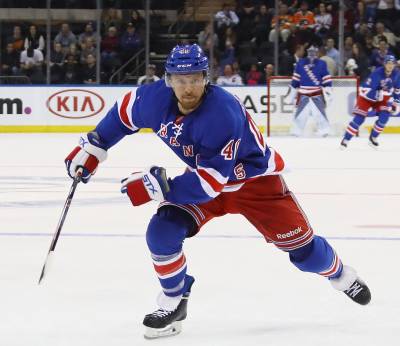Anthony Donskov
Hockey Sense: Installment #6
- Font size: Larger Smaller
- Hits: 2097
- Subscribe to this entry
- Bookmark
The hockey stride has been described by bio-mechanists as biphasic in nature consisting of alternating periods of single leg and double leg support. The single support phase corresponds to a period of glide, while the double support phase corresponds to the onset and preparation of propulsion (Marino, 1977). Ankle mobility may play a role at increasing stride efficiency. Increased range of motion, in particular dorsiflexion (think toes pointed up towards the sky), may aid the skater in assuming a lower skating position, thus reducing air resistance, while simultaneously increasing impulse, or the time the player has to produce force. In addition, pre-stretching the achilleas may increase kinetic energy thus increasing propulsion. Using electrogoniometers, researchers measured foot kinematics on the ice during a parallel start from defensive-zone face-off circle to offensive zone face-off circle. The acceleration phase occurred during the first 5 steps with steps 6-10 representing steady state. The following findings were recorded based on the average measurements of the sample size: (Pearsall et al., 2001)

- At the instant of single leg support phase, the skate was dorsiflexed 7.1 degrees
- As the double support phase began (loading prior to propulsion), ankle dorsiflexion reached 11.8 degrees
- Once push off was complete the swing phase began with 1.9 degrees of ankle dorsiflexion
- The skate was dorsiflexed throughout the entire stride cycle. Researchers have explained this as a means of preventing the tip of the skate from touching the ice causing unwanted friction
The paradox of ankle mobility is the need for stiffness around the joint during play. Hockey skates are engineered to provide structural support, and stability in a very different capacity than traditional running shoes. Due to the near frictionless environment, players must produce a force perpendicular to the skate blade to propel themselves forward. Doing this with minimal support/stiffness may impair force production. Robbing Peter (stability) to pay Paul (mobility) may pose to be a fruitless effort as many players have a personal preference regarding skate stiffness. Although more research on kinematics of the ankle is warranted, we have made a conscious effort to focus on this anatomical area daily. It starts when a potential player comes in for an evaluation and is a staple in our prehab work as a means of addressing limitations imposed from the repetitive posture of sport. Ankle dorsiflexion is one of many kinematic variables dictating stride efficiency, as such, it should be measured and managed.
Yours in Hockey
Anthony Donskov
